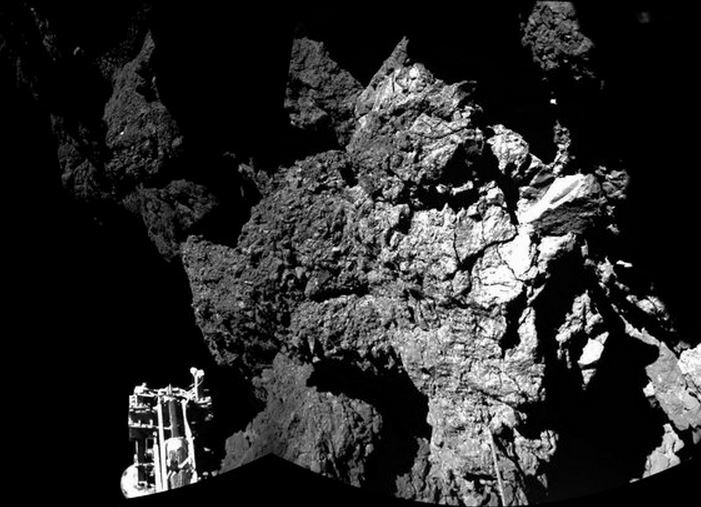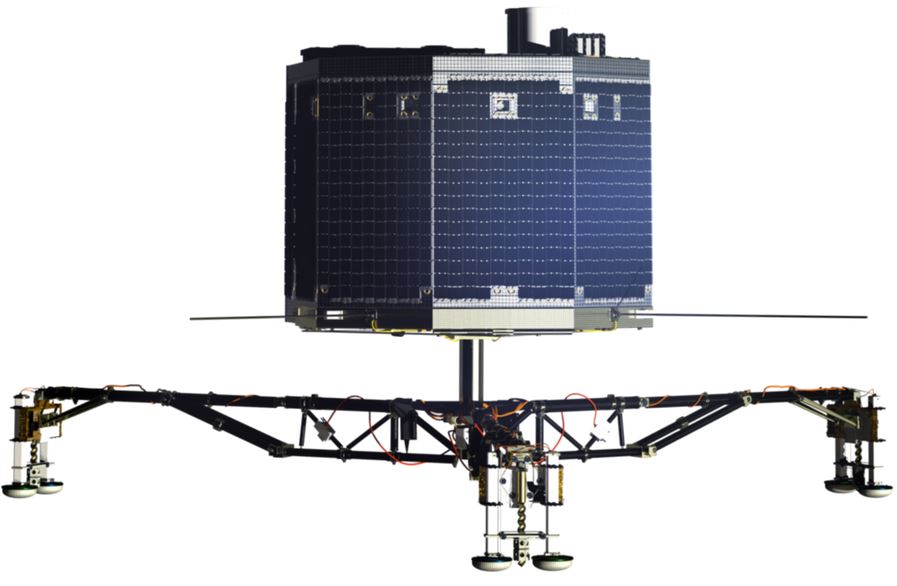The Philae lander, which has been in hibernation on the dark side of comet 67P/Churyumov-Gerasimenko, has not had enough juice in its solar-powered batteries to determine whether it is operational. Now that it is on the sunny side and the orbiting Rosetta mothership is directly aligned with it, European Space Agency scientists hope to be able to make contact.
Philae’s hard landing on the dark part of the destination comet has meant its batteries have no power.
The team’s technical manager, Koen Geurts, said “We don’t think we’ll hear anything just yet, but we cannot be very sure.”

Rosetta’s lander Philae is safely on the surface of Comet 67P/Churyumov-Gerasimenko. One of its three feet can be seen in the foreground. (Image: ESA)
More solar energy now
Lander Project Manager, Stephan Ulamec, from the German Aerospace Center, said:
“Philae currently receives about twice as much solar energy as it did in November last year.”
The comet, Rosetta and Philae are currently 320 million kilometers (198m miles) from the Sun. “It will probably still be too cold for the lander to wake up, but it is worth trying. The prospects will improve with each passing day,” said Ulamec.
Mission control will be continuously sending signals to Philae until March 20th, after which the probe will be out of the necessary orbit.
Landing was not according to plan
The original plan was to land Philae on the sunny side of the comet, and receive readings and data on its analysis of the nucleus of the comet for several months.
Unfortunately, when it landed on 67P it bounced and carried on bouncing for two hours before ending up in the shadow of a crater where its solar panels were unable to absorb the Sun’s rays.

Philae’s mission is to land on a comet, attach itself, and transmit data about its composition. (Image: Wikimedia)
Before its batteries went flat, Philae managed to deploy its instruments successfully, including a hammer and ice pick drill, which are designed to gather samples from the surface for analysis.
ESA (European Space Agency) scientists want to determine whether comets might have water and complex organic compounds. If they do, they might have brought the building blocks of life to Earth billions of years ago.
Worried about low temperatures
Lead lander scientist, Jean-Pierre Bibring (IAS, Orsay, France), said on Thursday:
“The largest uncertainty though is whether Philae’s internal systems have suffered from the terribly low temperatures of the environment. Is the daily solar input on Philae sufficient to have enabled its survival to operate again?”
Philae has to meet several conditions before it can start operating again and allow scientists to put it to work. Before waking up from its winter hibernation, its interior must be at least -45ºC.
At Abydos, its new landing site, very little sunlight reaches the lander, while temperatures are considerably lower than originally planned.
For it to wake up, Philae needs to generate at least 5.5 watts using its solar panels. “It has not remained idle during hibernation,” the scientists point out.
As soon as it ‘realizes’ that it is getting more than 5.5 watts of power and its internal temperature is warmer than –45ºC, it will switch itself back on, heat up further and try to charge its battery.
Contact during comet daytime
As soon as it is awakened, Philae is programmed to switch on its receiver every thirty minutes and listen for a signal from the orbiter Rosetta. This can be done in a very low power state.
Geurts said:
“At this time, we do not yet know that the lander is awake. To send us an answer, Philae must also turn its transmitter – and that requires additional power.”
Philae may already have woken up from its winter slumber, but does not yet have enough power to send a signal to Rosetta, which relays its messages back to Earth. In order to operate and allow two-way communication, it needs at least 19 watts.
Until March 20th, Rosetta will be transmitting to Philae and listening for a response.
According to the ESA:
“The most likely time for contact is during the 11 flybys where the orbiter’s path puts it in a particularly favourable position with respect to the lander during comet ‘daytime’ – when Philae is in sunlight and being supplied with power by its solar panels.”
“Communication will be attempted continuously because Philae’s environment could have changed since landing in November 2014.”
ESA Video – Ambition
This ESA film “Ambition” explains the ultimate aim of the Rosetta mission. To determine what comets are made of, and whether water and the building blocks of life on Earth might have come from them.
